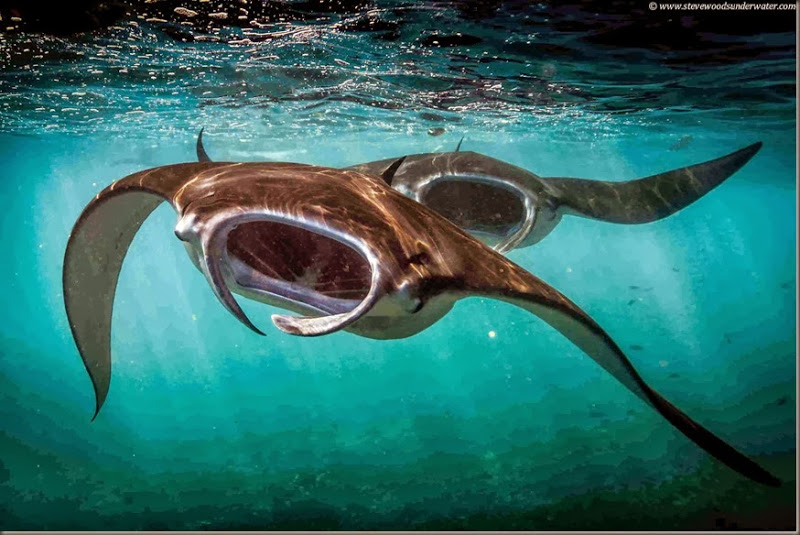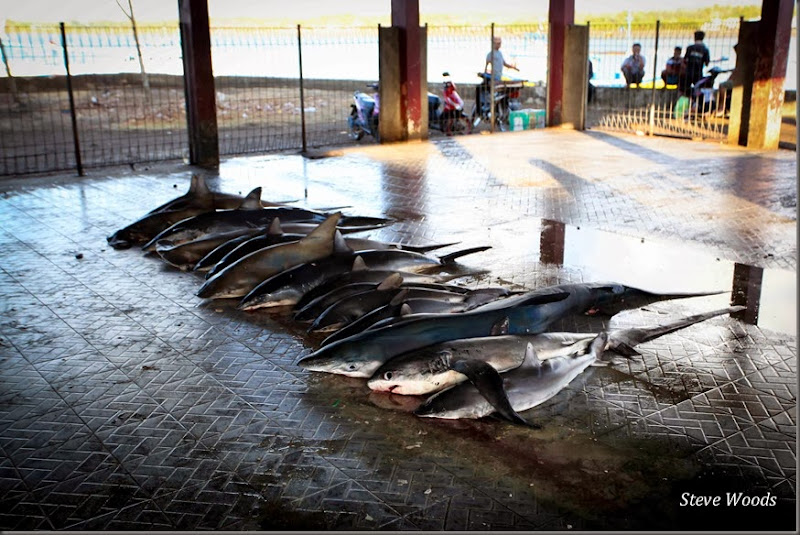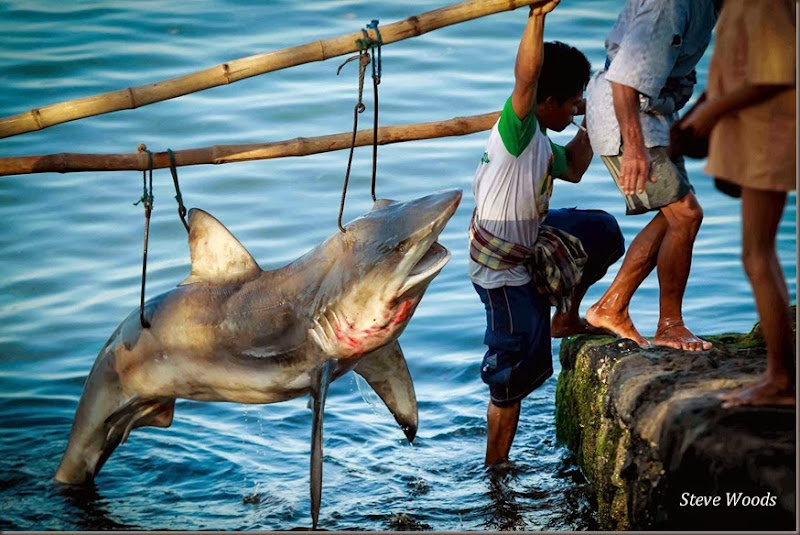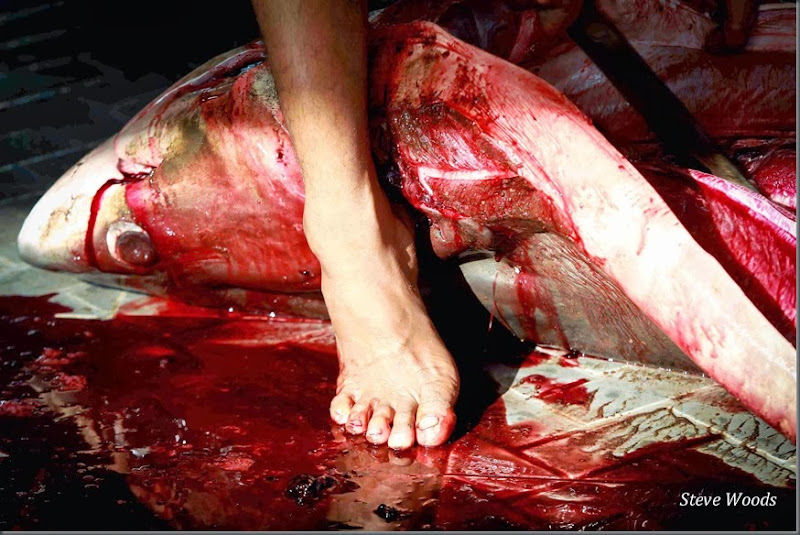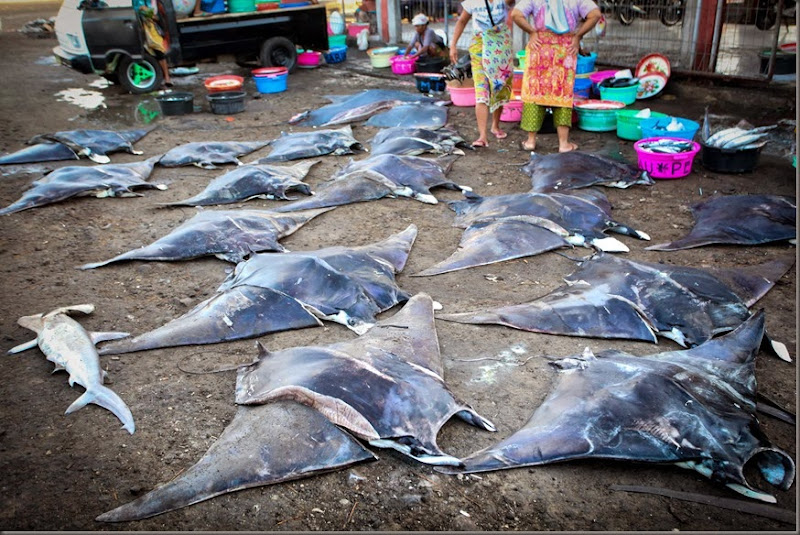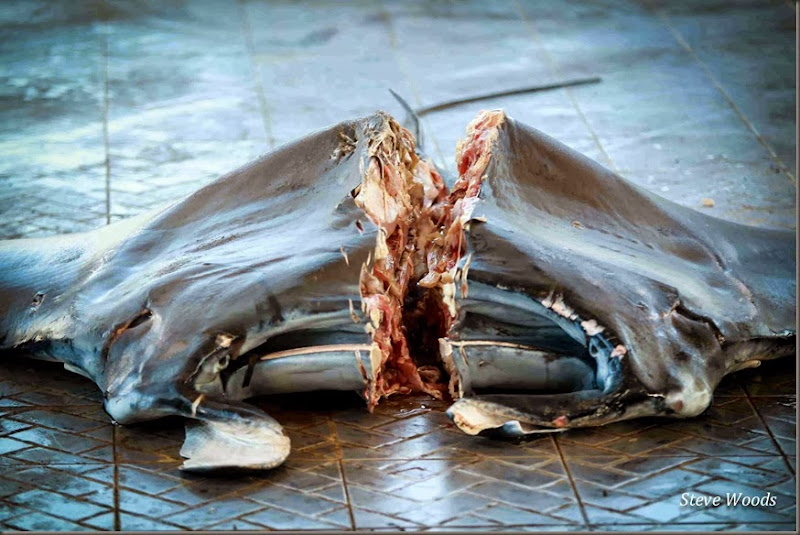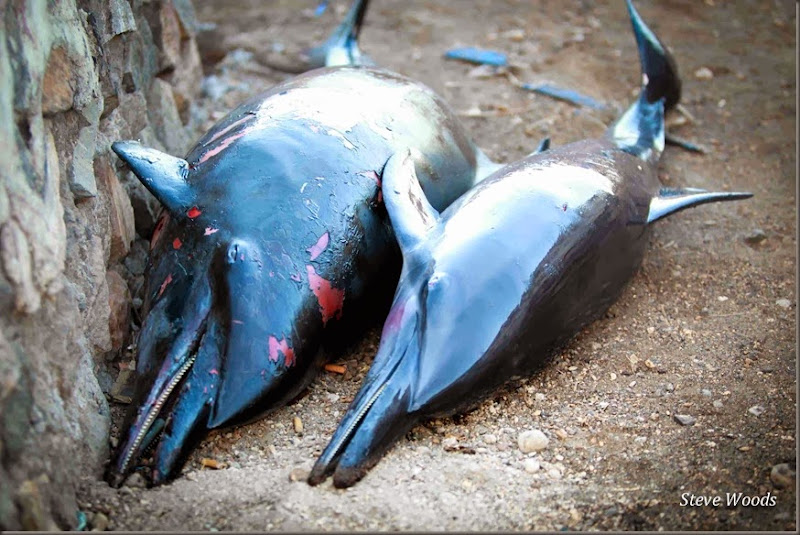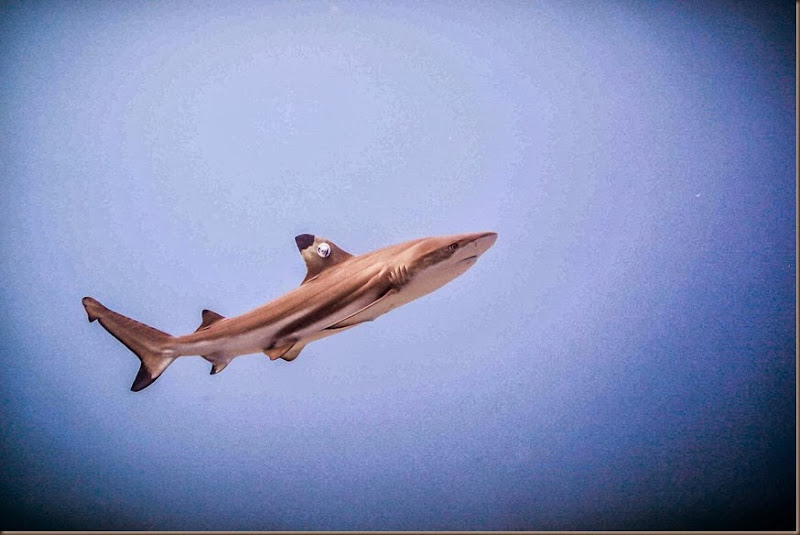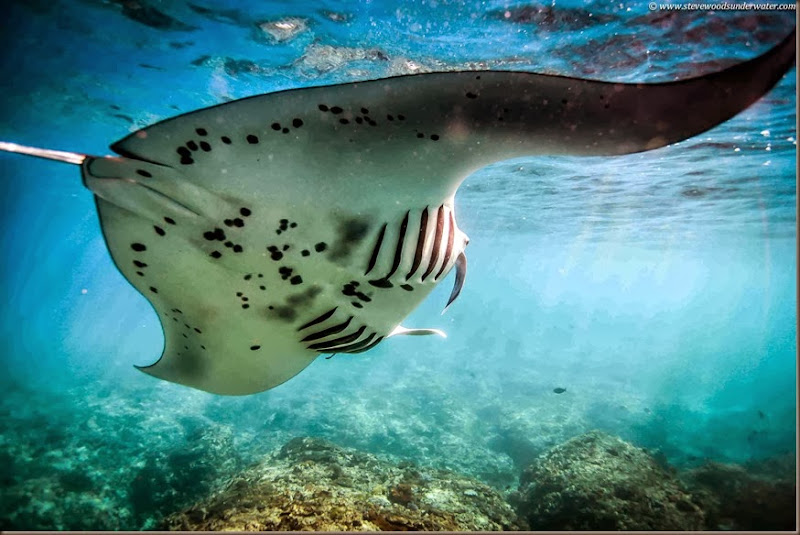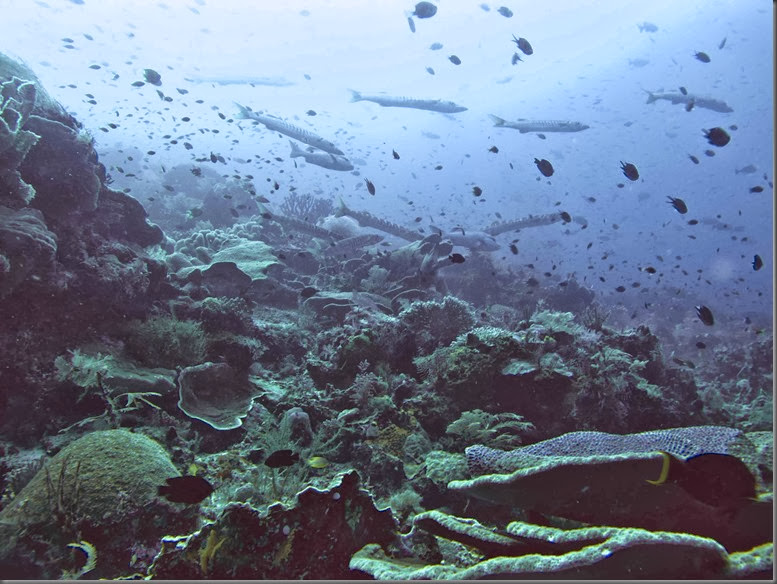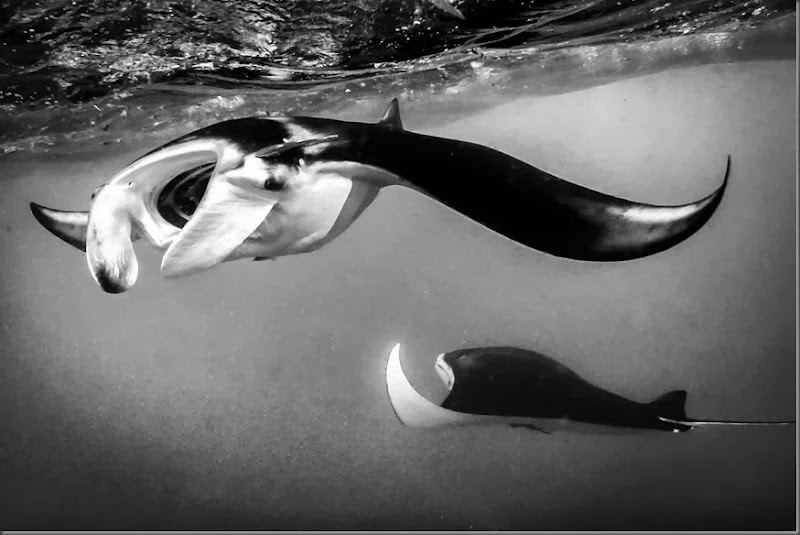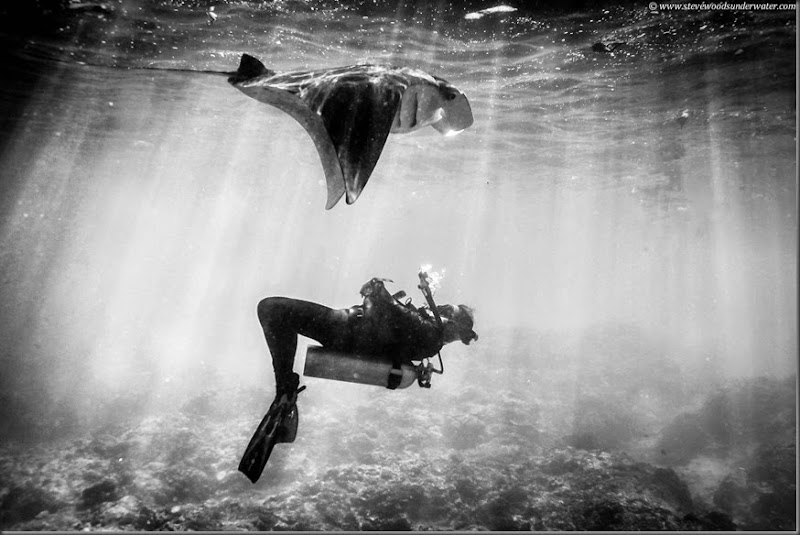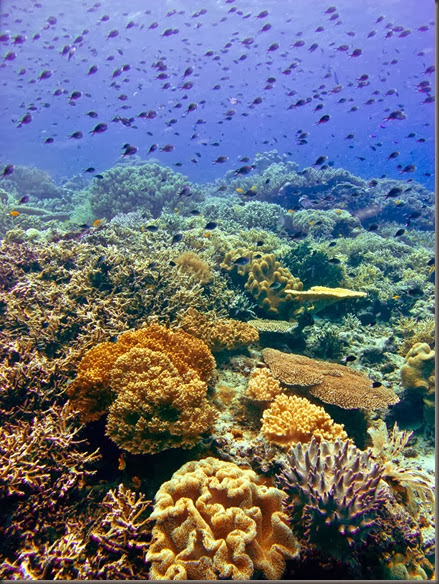They are the front line. They are the reason Raja Ampat is what it is and continues to be a world class dive destination. Without this group of dedicated conservationists the apex of the coral triangle would be over fished. Dynamite fishing and netting would quickly turn this paradise into a barren underwater environment void of the wonders that make this place the best in the world for diving.

We met Steve, Simon, Steph and Dr. Matt (from left to right below) at the northern tip of Fam Island as Josje and I were in Maggie, our tender, trying to lead Delos into a safe spot for the night. We don’t see many westerners out here so we were a bit surprised. “White people!?” I discreetly said to Josje as I saw a tender leaving the beach and heading for us. Two seconds later the hand held VHF came to life with Brian’s voice, as surprised as we were, “Dem Fella white people?” (yea, we still sometimes talk in pidgin English, a habit we picked up in Vanuatu and Solomon Islands) The timing of Brian’s pidgin English transmission was perfect, as if he heard what I was saying to Josje. After exchanging names and talking a bit about what they were doing out here and the amazing underwater world around us, they went back to their home base, motor vessel Hang Tuah anchored a few bays over. Two days went by at our secluded anchorage in Northern Fam Island where we enjoyed the beach complete with a bonfire and amazing snorkeling. With diving on our mind we headed north to Penemu to track down our new friends. Not that we don’t all love each other’s company but it is nice to sometimes interact with people from outside the walls of Delos, especially fellow divers!

Hang Tuah is home to the Sea Sanctuaries Program. Simon has spent over 3 years out here trying to get their message across and give hope to the future of this area. Hang Tuah was moored right in the center of a few islands on the Eastern side of Penemu in plain sight, as if they wanted to be seen from all directions. We thought it was an interesting place to moor; Not very protected from the wind or swell and not really near land, but maybe they were over a sweet dive spot? We dropped the hook on the Eastern side of Penemu as well, a mile or so away from their mooring and hailed them on the radio. Right away Simon welcomed us on board and invited us to tag along with them on a dive later that afternoon.
“Hows it going?” I said from the dinghy as we pulled up alongside Hang Tuah. “Ah, ya know, just saving the world” Steve replied, with a slight smirk. Not in an egotistical way but in a very genuine way that made you realize, all at once, he was telling the truth, joking and saying something very cliché. “This is the bulls eye of the coral triangle! This is the exact point where the highest density of fish and coral species are found in the world!” Simon explained to us as we got a tour of the 42 meter research vessel. You could instantly feel all of their excitement and passion when they explained to us what they were doing out here and why they were doing it. Steve, the photographer of the boat, went on to show us heart breaking pictures of dolphins, pilot whales, thresher sharks, manta rays, turtles, and countless other species, all being slaughtered for their meat to be sold at the worst fishing market in the world located in Tanjung Luar, Lombok, Indonesia. “They put long nets out in the water, huge nets, and circle the biggest area they can around reefs and coral. Whatever they pull in, is sold, most of which are endangered species” Steve added as he flipped through the terrible pictures.
(I know the pictures above are terribly gruesome but this is the reality of what is happening)
This is exactly why Hang Tuah is moored in the open at the apex of it all! They want to be seen! And they want to see everything as well. Not only are they in the Coral Triangle, that stretches from Singapore to S. Japan then to the Great Barrier Reef, but they are in the exact center of this triangle! As Simon puts it, “The bulls eye of the bulls eye of marine bio-diversity of the entire world!” That’s a pretty intense statement to take in but he’s right; the bio-diversity of this area truly is mind boggling. Delos is anchored about a mile from a small rock island, Batu Rufus, that doesn’t look like much from the surface but turns out to be the second largest count of marine species in the world. The spot that takes the number one for most species is a mere 15 miles away at Cape Kri.
Once underwater you are overwhelmed with the amount of life. I find my self thinking of the reefs here as a huge overpopulated city. Just as crosswalks in New York city are filled with 1,000’s at a time all going in opposite directions, so to is the reef. Every animal is on a mission; From the giant hump head wrasse to the tiniest Plankton everything has a place to be and a task at hand. The walls are like huge sky rise buildings with every square inch of real estate occupied by hard corals, soft corals and an assortment of critters, all different colors and sizes. This is exactly why these fishermen want to come here, and collect whatever they can to be sold on the black market.
So how do they combat this destruction of the marine environment? First and foremost they are setting up patrols and getting the local villages involved. They are even building a watchtower from which the entire area can be observed and protected. The biggest problem they run into is getting the local villages involved in the cause. Dr. Matt is in the process of researching the area and determining what species are specifically in danger. Then he will be able to propose a plan for the locals to follow. For centuries all the fisherman in Indonesia have fished sustainably until international demand rose and motorized boats came into the picture. These fisherman still have the same mindset to catch and sell fish to make a living and feed their families. But the main difference is with the advent of dynamite, motorized boats and massive nets, the amount they take is no longer just to feed their village or their families; it is no longer sustainable and greed begins to take over.
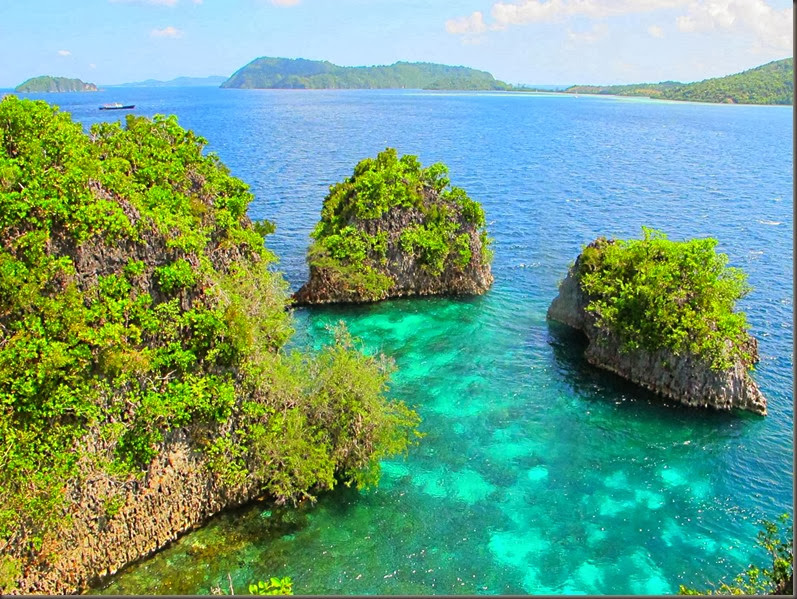
I think it’s the most basic of human instincts; to always want more, to be greedy, to have as much as you possibly can. It is exactly what happens to any culture, whether it be logging unsustainably or drilling for oil, the consequences and impacts on future generations are hazed over with the thoughts of a new house, a new car, a new cell phone, new clothes and satellite TV.
In saying this, the local fishermen in the surrounding area are only a small, small percentage of the bigger picture. They are not the biggest part of the problem and for the most part, use traditional single-line fishing methods. It is in fact the larger and greedier international groups that are coming in for the big kills. The Chinese, Vietnamese, and Thai, just to name a few, are illegally coming into areas like Raja Ampat, dragging nets and using dynamite, killing anything in their path and leaving behind a trail of barren dead coral and irreversible impacts in the local fish population that the local villages rely so heavily on. All for the thought of a little bit of money.
The idea of the Sea Sanctuaries program is to get volunteers involved from all over the world and educate the local villages about the impacts of these actions. They are really trying to promote conservation for future generations. With the danger of the collapse of marine ecosystems that may be looming in the near future, developing regiments of volunteers could be considered a top priority. So, a volunteer who may be a novice in Scuba Diving could make as much of a difference as an experienced diver could with proper knowledge. After all, the goal may simply be looked at as the restoration of a depleting habitat.
As we move into the future, the marine population consisting of various sea creatures may gradually die off, causing a steep decline and imbalance in the marine ecosystem. This could spell doom for water bodies as well as the fishermen dependent on them for sustenance.
“One man in a nearby village spoke of a time when they would put the rice on and then go out and fish, knowing that they would return with dinner by the time the rice was done. Now it is the opposite. Hours and hours can be spent trying to catch enough fish for a single-family” Simon explained to us.
It’s really tough out here for the Sea Sanctuaries crew though. They take 3 steps forward and 2, sometimes 4 steps backward. While we were there they received what seemed like an “extortion” letter. A local village seemed to get a bit jealous that Hang Tuah had recently visited a neighboring village, buying coconut oil and showing them other ways of making an income. The second village wants their cut too. Steph spoke of times when they were threatened and actually felt scared. “It’s a fine line to balance,” Steve added. “We try and hand over hard cash as a last resort. Instead, we give them things or do things for the village that shows our respect for them and that we are thankful to be here” Simon Explained. From the local’s point of view, these guys look like rich tourists that are coming in and telling them how to handle their native area and when and where to fish. Imagine someone coming into your neighborhood, not speaking your language and trying to convince you that the things you and your ancestors have been doing for centuries may not be possible anymore and need to change.
It is working though. Slowly but surely progress is being made. Other areas of Raja Ampat like MER (Misool Eco Resort) and Sorido Bay on Kri Island are seeing huge results from their conservation efforts. All of the “good” pictures on this blog were taken in some form of protected area. Misool Eco resort has created a massive no take zone encompassing 1,000 SQKM and slowly the shark population is rebounding. Same with Sorido Bay. Because they employ locals there is no longer a need to make money from over fishing the area. Indonesians are brought in and taught skills like boat building and construction. With the help of the locals they also build small resorts and get them involved in patrolling the newly formed protected areas.
The diving out here is truly incredible. As Josje mentioned in Underwater Wonderland, pictures and video just don’t do it justice. We were lucky enough to go on a few dives with the Sea Sanctuaries crew and see exactly what it is they are working so hard to protect. Coral, critters and fish cover every square inch of the underwater topography. In fact, two new species were found in February and countless more are most likely hiding in the jumble of living organisms we pass over on every dive. It’s breathtaking and you can easily catch the “conservation fever”. Although we can’t hang around and really help these guys out on the front line hopefully we can spread the word and pass on the Sea Sanctuaries message. Dr. Matt put it very simply “If the reefs die, we die; the oceans are the lungs of the world and when the lungs collapse everything will come to an end “. Almost TWICE as much oxygen comes from the ocean than from the rainforests of the world so it doesn’t take a rocket scientist to connect the dots. You go to the lung doctor when you feel there is a problem with your breathing. So why don’t we do something that will help the marine ecosystem thrive better? Why are we hell bent on destroying the lungs of the world, and in turn, ours as well? Many people often shirk away the responsibility by stating that this sort of thing doesn’t affect them personally, and is therefore not their responsibility. However, that’s not entirely true, is it? People do care for things that do not always personally affect them, because most people care for more than themselves. If a tree is presenting to be a hazard in your garden or neighborhood, for example, or it needs some amount of professional care to live and thrive, then either you or someone you know would call in a professional to conduct Tree Surgery on it. Most people, if you notice, care when they are made aware of the risks. This is why spreading awareness about the coral reef problem is important. They are the trees of our oceans, after all.
If things continue the way they are, unfortunately the same coral and animals that are in these pictures will most likely be gone, gone forever, within a generation. The Sea Sanctuaries crew and the other conservationists are doing their best to protect this extremely important part of our world. The fact of the matter is that they are only slowing this inevitable destruction. Unless…people like you and me actually do something about it.
So what can you do? Open your mind a bit and check what is sustainable and what isn’t. Start from your home. You can adopt sustainable living methods to reduce your ecological footprint and save the environment from a very basic stage. Reduce the use of plastic and other harmful materials personally since they might just end up in the ocean. Moreover, instead of disposing off plastic items in a regular garbage bin, you can hire a service for Junk removal Melbourne (or in other locations), so that the plastic can be properly recycled and reused in manufacturing other commodities.
Once you have achieved a sustainable lifestyle, you can move outwards and work on your surroundings. Keep the local areas clean, plant more trees, reduce water waste, and more. You can also weekly volunteer for beach cleaning, and if you have experience with swimming in deep waters, you can also join a local group or organization that works on cleaning oceans.
Moreover, keep up with what seafood is ok to eat and what isn’t, especially the endangered sea species. If you want, learn to scuba dive and be part of a reef conservation group. Better yet, go out and volunteer with any environmental organization working for ecosystem improvement!! Check out some of the sites below for more info.
To Volunteer – www.seasanctuaries.org
Sustainability in Australia – www.Sustainableseafood.org.au
World guide to seafood restaurants – www.fish2fork.com
Seafood guide – www.nrdc.org/oceans/seafoodguide/
Seafood guide – www.greenpeace.org/usa/en/campaigns/oceans/seafood/
Save the Coral – www.coral.org
TAKE ACTION – www.wikihow.com/Take-Action-to-Save-Coral-ReefsA special thanks to Steve Woods for letting us share some of his photographs – www.stevewoodsphotography.com

